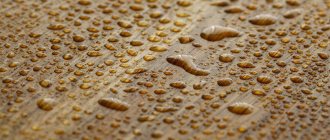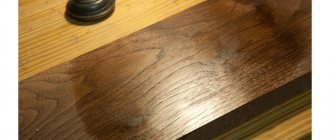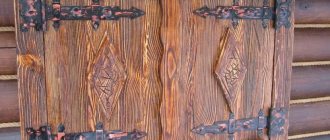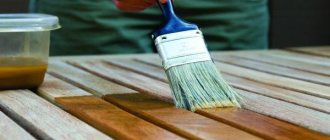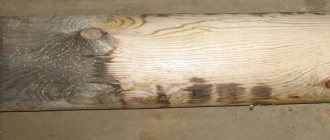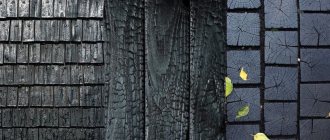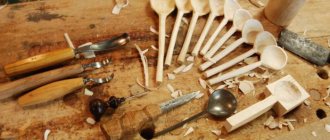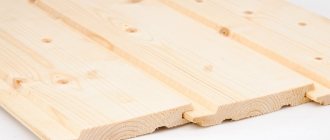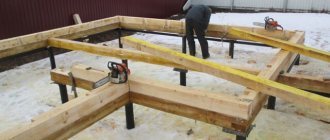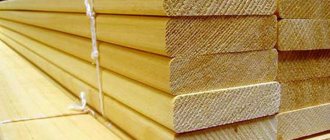The question of how to treat the lining in a bathhouse is asked by every fan of whipping himself with a broom.
Lining is widely used for renovation of bath rooms. Panels made of various materials are used as finishing materials. The materials used have different technical and performance characteristics. These differences must be taken into account when choosing a protective agent.
Why is lining treated in a bathhouse?
Rooms with low humidity and temperature stability are lined with clapboard made of wood, plastic, and metal. Such rooms include an entrance hall, a dressing room, and a wash room.
In rooms with high humidity and large temperature differences (steam room, sauna), the advantages of wooden lining are used. These include:
- High moisture resistance;
- Low thermal conductivity;
- Resistance to aggressive environments;
- Durability;
- Practicality.
During operation, the lining loses its original properties. The tree darkens over time. The surface wears off and becomes rough. In damp rooms, the lining is susceptible to rotting. In dry rooms, the material dries, cracks and collapses.
A decrease in indicators for at least one characteristic leads to the need to replace the material. To restore the original or close to it indicators, the lining is treated with various materials.
Is it necessary to treat the lining in a bathhouse?
On the question of how to treat the lining inside a bathhouse, there are three different opinions:
- It is necessary to process the lining;
- The lining should not be processed;
- The lining should be processed selectively.
Supporters of the first opinion consider lining treatment to be a natural way to extend the service life of products. Coating the wood with special products helps restore the water resistance of the coating.
Deep penetration of processing compounds protects the structure of the material from mold and other fungal diseases. Filling the surface pores favorably emphasizes the unique texture of the wood. The wood pattern becomes bright and rich, thereby improving the aesthetic properties of wooden products.
Attention! The use of paints and varnishes for finishing lining in a bathhouse is strictly prohibited. The harmful substances contained in oil paints have a detrimental effect on human health.
When processing wood, preference should be given to products of plant origin. Many industrial products are safe for human health and the environment.
Proponents of a categorical refusal to use special processing argue their opinion by the presence of harmful chemical components in such compositions. Any industrial product contains toxic substances.
At high temperatures, these substances enter the air and onto the surface of bathhouses. When you inhale moist air, harmful substances enter the body. Skin contact with the treated surface may cause chemical burns and allergic reactions.
Proponents of the selective use of special compounds advise paying attention to the specifics of the mixtures used and the characteristics of the premises. The hallway and rest room have low temperatures and humidity. Wood processing can be carried out in such premises. Exposure to chemicals will be minimal or non-existent.
The steam room, sauna and pool room do not need to be treated. As a preventative measure, these areas require constant maintenance and cleaning after use.
Stages of wood impregnation
Linseed oils are used for wood processing in two ways, it all depends on personal preferences and the size of the surfaces being treated:
- Soaking is only suitable for small items (decorative figurines, dishes, etc.);
- Coating (rubbing in).
The following steps will tell you how to treat wood with linseed oil impregnation.
Preparatory stage
Before you start coating wood at home, you must first carefully prepare the surface to be treated. If this is a newly manufactured product, then the surface is simply sanded with high quality using fine sandpaper. Impregnating wooden products with a large area, for example, the facade of a house or previously exposed surfaces, is a little more difficult.
Preparatory work algorithm:
- Get rid of the old coating, that is, varnish or paint. There are several methods you can use here. Try removing the old paint using a spatula and a wire brush. If it doesn’t work, then you need to use a hair dryer.
- Sanding the surface. For this process, sandpaper with varying degrees of abrasive coating is used. You should start with the larger one, gradually reaching the smallest one. The surface is ready if, after running your hand over it, we do not feel any irregularities.
- Remove dust using a soft brush and rag. The key to high-quality oiling with linseed oil for wood is a well-cleaned surface from dust.
Coating process
Oiling of prepared wood can be done using the oiling method. The oil is applied either with an ordinary soft rag or with a brush that has natural bristles. Although painting with a brush is only suitable for small areas. As for the facade of the house, ceilings and other things, you only need to apply oil to the wood with a rag.
Linseed oil for wood is applied according to the following algorithm:
- Pre-stir the composition and pour the required amount into a clean container.
- Moisten a rag and treat the surface with it. It is necessary to apply the composition along the wood fibers.
- After treating the wood with linseed oil, you need to let the surface dry for about 20 minutes, then remove the excess with a clean rag.
- The product soaked in wood coating oil is left to dry for some time, and then the wood is re-coated with linseed oils.
Soaking process
Processing wood by soaking, as mentioned above, is only suitable for small products. The process of soaking wood with oil is quite simple: oil is poured into a clean container, and then the prepared, dust-free product is placed there. You can hold it as long as you like.
After the product has been soaked for some time, it is removed and placed on paper in an inclined state. This will allow excess flaxseed oil to drain. When we have got rid of the excess, polish the surface with a clean and soft cloth. Next, leave the product to dry.
The technology for oiling wood with linseed oil is quite simple, but it will reliably protect it from the effects of negative factors. And, if we compare it with various types of industrial compounds, then it is possible to coat wood with oils without harm to human health. Processing wooden products is a process that should not be neglected.
Features of protective equipment for baths
A large assortment of paint and varnish products and wood care mixtures is presented by imported and domestic manufacturers.
All wood processing products in the bathhouse are divided into two types:
- For treating surfaces not in contact with skin (ceiling, walls);
- For treating surfaces in close contact with the skin (shelves in the steam room and sauna).
Mixtures for treating walls and ceilings form a thin protective film on the surface being treated. In case of contact with skin, there is a risk of an allergic reaction or chemical burn.
Steam room care compositions penetrate deep into the wood. Chemicals do not come into contact with the skin.
The best products for treating walls and ceilings in baths
Here we will answer in detail the question of how to treat the lining inside a bathhouse, and highlight the main characteristics of protective agents.
Imported products for treating walls and ceilings
The leaders in the production of wood care mixtures among foreign manufacturers are Teknos (both from Finland) and Belinka Belles from Slovenia.
One of the best ways to protect wood in a bathhouse is the antibacterial impregnation “Tikkurila Supi Saunasuoja” (“Tikkurila Supi Saunasuoja”).
The mixture is designed to protect wet areas with high temperatures. Available in one-component and two-component versions.
The one-component composition has a transparent color. Used to preserve the natural grain of the wood.
Two-component impregnation allows you to add colors of various shades. To obtain the required shade, it is necessary to perform a control application. The final color depends on the type of wood, its hardness and humidity.
Advice. Before purchasing lining, check the information about the manufacturer and methods of wood processing. The information provided will allow you to select the correct composition for caring for the clapboard during its further use.
When dried, it forms a durable, moisture-resistant and dirt-repellent film. Apply with a brush or roller in 2 layers at room temperature.
The acrylic composition “Supi Arctic” (“Supi Arctic”) protects the surface of walls and ceilings from rotting. Prevents the formation of blue stains and mold. A special feature of the composition is the pearlescent pigment in its composition. The tinting additive gives the surface a unique pearlescent shine.
Water-based acrylic varnish of the “Natura” series is very popular. The mixture is odorless and colorless. Levels out well. It is highly resistant to sunlight. Does not lose reflective properties over time. To give the desired shade, the mixture can be tinted.
"Interier Sauna" is resistant to high humidity. It is colorless and odorless. Resistant to food fats and cleaning powders. Has a silky shine.
Domestic products for treating walls and ceilings
Among domestic manufacturers, Senezh also occupies a leading position.
One of the best among domestic products is the antiseptic “Sauna” from. The drug is used to protect the surface from moisture. It is odorless and colorless. Has an excellent antibacterial effect. Preserves the natural color, natural smell and unique structure of wood.
Acrylic-based protective varnish “Sauna” is designed to protect wood from dampness and rot. Has high antibacterial properties. It is odorless and completely transparent. Effectively protects wood from darkening and fungal diseases.
Types of wooden profiles
Before processing the lining in the bathhouse, you need to select the type of profile. Woodworking enterprises produce five types of panels. The boards have different cross-sectional shapes:
- standard;
- calm;
- Europrofile;
- eurolining;
- American.
Standard
The cross section of the board looks like a trapezoid, the edges of which are beveled at an angle of 30°. There are longitudinal ventilation grooves on the back side of the panel. The side surfaces have a groove on one side and a tenon on the other. The tenon is made somewhat narrower than the groove. When saturated with moisture, the protrusion swells, the lock becomes dense and practically inseparable.
Calm
Boards of this type have rounded longitudinal edges. Otherwise, the lumber is similar to the above type.
Sectional view of the Shtil cladding board
Europrofile
The board has a wide tenon, which makes the connections particularly reliable. Because of this property, they try not to use this type of finishing for baths. Moisture saturation can lead to cracking of the locking fasteners.
Eurolining
The surface of such materials looks like boards interspersed with thin depressions. A high tenon forms a gap between the panels, this creates a beautiful wood texture. On the back side of the panels, ventilation ducts prevent condensation from forming, which prevents rotting of the sheathing wood.
Eurolining assembly
American
The profile, unlike eurolining, has a beveled edge, which gives the impression of laying the boards overlapping. This type of cladding is used for finishing the facades of wooden houses.
In addition, the shape of the boards is imitated by plastic and MDF panels. Bathroom walls are not decorated from these materials due to poor technical characteristics.
For finishing interior walls, two types of profiles are acceptable: Standard and Shtil. This follows from the fact that finishing with such boards is the simplest and most cost-effective.
The best products for treating shelves
Protective compounds for treating shelves and benches are characterized by the absence of allergens and complete safety for human health.
We propose to consider in detail the question of how to treat the lining in a bath and what compositions will be needed for this.
Imported products for processing shelves and benches
The deep penetration paraffin oil “Tikkurila Supi Laudesuoja” received positive reviews.
Intended for application to untreated and previously treated surfaces. The drug has no odor. Apply with a brush or rag at a temperature of at least +5° C.
The bath must be heated before use. The surface of the shelves is sanded with sandpaper. Remaining dust and dirt are removed with a solution of Tikkurila Supi Saunapesu detergent.
The treated surface can be used after the oil has completely absorbed into the wood. In case of rapid absorption, the treatment is repeated. Remaining oil is removed with a clean cloth. The rate of oil penetration depends on the degree of porosity of the wood.
The protective composition with natural wax “Supi Saunavaha” (“Supi Saunavaha”) penetrates deeply into the wood. A durable water- and dirt-repellent natural film is formed on the surface. Excellent protection against mold and blue stains.
Apply to a dry, clean surface. Not suitable for previously treated surfaces. To give a shade, the addition of a color pigment is used. The bath must be warmed up before use. The next layer is applied after the first layer is completely absorbed. Excess wax is removed with a sponge or rag.
Natural paraffin oil from the Sauna Paraffin series gives the surface increased heat resistance and a silky shine. It is colorless and odorless. Apply in 1-2 layers using a sponge or brush. Dries within 24 hours.
Domestic products for treating shelves and benches
Among domestic products, the acrylic antiseptic “Neomid 200” has gained the greatest popularity. The drug has a high degree of protection of wood from rotting. Capable of stopping destructive processes that have begun. Preserves the natural color and texture of wood.
"Oil for baths and saunas" from "Neomid" is used to protect wood from rotting. Perfectly protects against pests. Has no irritating effect. Preserves and emphasizes the structure of wood.
Impregnation technologies
There are different ways to oil wood. Some people prefer smearing and further rubbing, while others prefer soaking. True, the second method is suitable only for small objects - decorative dishes, figurines. The dish, by the way, can be used (as a container for bread, salt/sugar, fruit) because it is not at all afraid of water.
Preliminary stage
An important stage of work before impregnation will be the preliminary preparation of external/internal surfaces. For boiling, you will need to thoroughly sand the dishes or figurines. They are supposed to be freshly carved from wood and not covered with anything on top. Otherwise, you will have to remove both paint and varnish, and this is a very tedious task.
For large areas (walls, floor, ceiling) you will have to do much more:
- Rip off the old coating. This includes varnish and paint. Use a wire brush or spatula for cleaning. If the paint does not want to come off, heat it with a hair dryer. When it bubbles, lift the layer with a spatula and remove.
- Sand the surface. Use two types of sandpaper for this – coarse and fine. You can stop cleaning when you feel a smooth surface without flaws under your hand.
- Remove dust. Brush it off with a soft (Vietnamese) broom or use a regular rag. There should be no dust remaining on the surface before oil impregnation.
Coating
The easiest way to protect wood from moisture and rot is to oil it. It's best to do this with a rag. But you can also use a brush with natural bristles. This is relevant for small areas (platbands). Impregnate internal/external walls, ceiling or floor with a soft cloth soaked in oil. This is done as follows:
- Stir the product and pour some into a separate container.
- Dampen the rag and start soaking. Apply the composition along the fibers.
- Leave the oil for 15 - 20 minutes. Then remove the residue with a rag.
- Allow the surface to dry, then repeat the treatment.
Soaking
This method is used for small products. Pour oil into a container and place the pre-cleaned wooden product in it. The holding period is not limited. Ideally, you need to hold a plate, figurine, knife or gun handle until air bubbles stop escaping from the wood.
After this, take out the item and place it on a table covered with clean paper, tilted, so that excess oil drains off. Then take a rag and polish. Pure linseed oil without additives takes a long time to dry - up to 3 weeks. This has its own advantage - the depth of such impregnation is great, and the tree receives excellent protection from moisture, rot, and mold. If you can't wait to see the finished product, add beeswax to the linseed oil. This will significantly speed up the process.
Recipe for oil/wax composition based on linseed oil (suitable for both external and internal surfaces):
- Heat the oil until smoking.
- Pour grated wax into it.
- Stir. When the wax dissolves, pour the mixture into a jar.
- To give the mixture a pleasant aroma, add a few drops of juniper oil.
The ratio of parts in oil-based formulations may vary. To get a thin layer (floor treatment), take 9 - 10 parts of oil and 1 part of wax. Treatment with this composition is carried out 3 – 4 times. Compositions based on oil and wax 3 to 1 or 4 to 1 are suitable for impregnating walls. Oil/wax in a 1 to 1 ratio is acceptable for ceiling treatment. The layer it produces is thick, protection against moisture penetration is maximum, but resistance to mechanical damage is very weak. But the ceiling is not threatened by any outside influences. Therefore, a composition based on linseed oil with the addition of wax 1 to 1 is the most suitable option for it.
Impregnating wood with oil compounds is an inexpensive option for protecting it from various adverse factors. Compared to industrial antiseptics, it is cheap, high quality and completely safe for health at all stages of work.
